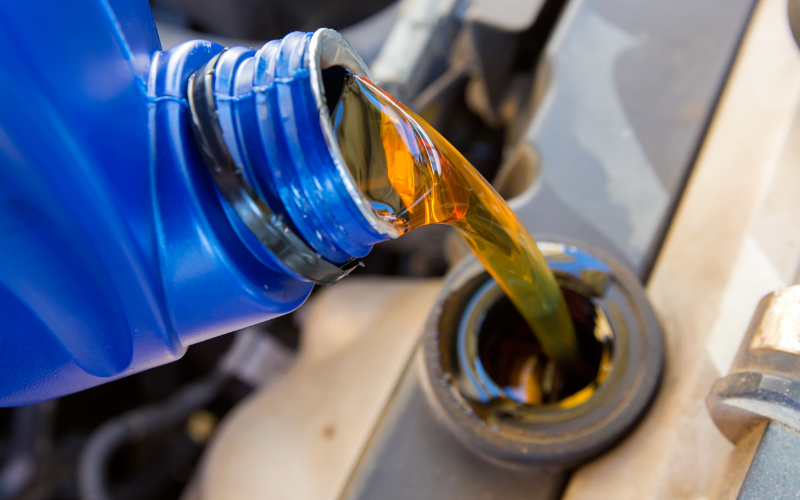I’ll be the first to admit that it’s pretty tempting to use the oil you have on hand for your small engines rather than make a trip to the store to buy a whole quart. And to be honest, sometimes it works out just fine. What it really comes down to is the properties of the oil that you’re using and the conditions that you’ll be running the engine in.
Between SAE 30 vs SAE 40, you’ll find a few key differences. Whether you are putting oil in your lawn mower, trimmer, or lawn tractor, it’s a good idea to be familiar with what the recommended uses are.
SAE 30 vs SAE 40 (The Short Version)
SAE 30 and SAE 40 are both single-grade motor oils that have been rated once at a high temperature. At room temperature, these oils will have a thickness or viscosity that is pretty similar, but when hot, SAE 40 will be more viscous than SAE 30. Because of this, SAE 40 is mainly used in high revving engines like motorcycles, boats, and cars. SAE 30 on the other hand, is commonly used in lawn mowers and other small engine equipment.
What’s the Difference Between SAE 30 and SAE 40?
The main difference between SAE 30 and SAE 40 is viscosity. What viscosity represents is a fluid’s resistance to flowing and is also referred to as “thickness” of a liquid. Thicker fluids have a higher viscosity and thinner fluids have a lower viscosity.
When it comes to oil, the Society of Automotive Engineers (SAE) has created a scale which is used to rate viscosity. It runs starting with the least viscous oils (0) and ending with most viscous oils (60). Both SAE 30 and SAE 40 are single-grade oils meaning they are only rated while hot, or in other words, near the temperature they will be inside of a warmed-up engine. So, SAE 30 is a median thickness oil and SAE 40 is a slightly thicker than average oil. Aside from viscosity, SAE 30 and SAE 40 are pretty similar.
The Characteristics of SAE 30 and Its Benefits
The main characteristic of SAE 30 is that it’s a medium-weight oil used mainly in small, air-cooled engines. This happens to fit the bill for almost all gas-powered lawn mowers. Since most mowing seasons don’t have to deal with cold weather, lawn mowers don’t need an oil that stays thin at freezing temperatures (like most multi-grade oils do). The benefit of using SAE 30 in a lawn mower is that it will lubricate the engine very well while hot, and will last a long time.
SAE 30 can also be used in most other smaller engine tools that are used in warm conditions. Another perk of using SAE 30 is that it’s widely available and usually less expensive than most multi-grade motor oils.
The Characteristics of SAE 40 and Its Benefits
Another single grade oil, SAE 40 is a slightly thicker or more viscous engine oil that works really well in bigger, hotter, engines. Like SAE 30, it isn’t a good fit for anything that needs to start in the cold. But some vehicles with smaller diesel engines and some motorcycles use SAE 40 because it can hold up to higher temperatures and lubricate more powerful motors.
When it comes to a lawn mower, SAE 40 isn’t my first choice. Though you can get away with using it, you don’t really need the added thickness for a small gas engine. In fact, the higher viscosity may actually put added strain on your mower’s engine.
FAQs About These Oils
Since they sit pretty close to each other on the Society of Automotive Engineers’ scale, a lot of people ask the same questions about SAE 30 vs SAE 40. The most common questions I have seen are listed below along with brief answers.
Can You Use SAE 40 Instead of SAE 30 in a Lawn Mower?
In a word, yes, you can use SAE 40 in your mower instead of SAE 30, but I wouldn’t recommend doing it. There are a lot of people who use whatever leftover oil they have sitting around (usually from their vehicles) in their lawn mower without ever running into problems. Or without running into obvious problems, that is.
But the truth is that your lawn mower probably doesn’t need an oil as thick as SAE 40. The engine on the average mower won’t run hot enough to require the additional viscosity, and you’ll probably just end up making the motor work harder than it needs to. With that being said, the best way to be sure about what oil to use is to consult the manufacturer’s guidelines. The engineers of your lawn mower designated a specific oil to use for a reason.
Is SAE 30 Thicker Than SAE 40?
Nope, SAE 30 is a thinner (less viscous) oil than SAE 40. Thickness, weight, and viscosity all refer to a liquid’s ability to flow. And once again, oils that are rated by the Society of Automotive Engineers (SAE) are designated a number to represent viscosity with lower numbers being less viscous and higher numbers being more viscous.
With that being said, at room temperature, SAE 30 and SAE 40 have a very similar “thickness”. Since they are both rated at 100 degrees celsius, the difference in viscosity is mainly noticeable after they’re heated. This also means that SAE 30 and SAE 40 will have a pretty similar viscosity when cooled. Since they’re single-grade oils, they don’t have any additives with thinning agents that lower their viscosity at low temperatures.



Leave a Reply